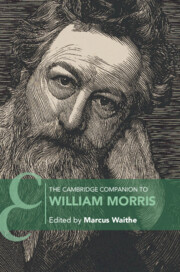Book contents
- The Cambridge Companion to William Morris
- The Cambridge Companion to William Morris
- Copyright page
- Dedication
- Contents
- Figures
- Notes on Contributors
- Acknowledgements
- Note on The Collected Works
- Chronology
- Abbreviations
- Introduction
- Part I Senses of Place
- Chapter 1 Oxford
- Chapter 2 Red House
- Chapter 3 Kelmscott Manor
- Chapter 4 The Thames Basin
- Part II Authorship
- Part III The Practical Arts
- Part IV Movements and Causes
- Part V Influences and Legacies
- Guide to Further Reading
- Index
- Cambridge Companions To …
Chapter 2 - Red House
from Part I - Senses of Place
Published online by Cambridge University Press: 03 May 2024
- The Cambridge Companion to William Morris
- The Cambridge Companion to William Morris
- Copyright page
- Dedication
- Contents
- Figures
- Notes on Contributors
- Acknowledgements
- Note on The Collected Works
- Chronology
- Abbreviations
- Introduction
- Part I Senses of Place
- Chapter 1 Oxford
- Chapter 2 Red House
- Chapter 3 Kelmscott Manor
- Chapter 4 The Thames Basin
- Part II Authorship
- Part III The Practical Arts
- Part IV Movements and Causes
- Part V Influences and Legacies
- Guide to Further Reading
- Index
- Cambridge Companions To …
Summary
Red House in Kent, was the only house William Morris ever commissioned and owned. Designed by his lifelong friend and collaborator, the architect Philip Webb in 1859–60; the house stands as the physical embodiment of Morris’s exuberant spirit, youthful ambition, romantic medievalism, and great sense of possibility. For five highly industrious and creatively charged years from 1860–5, it resounded with the ‘jovial campaign’ of decorating and furnishing and creating a garden to meet his emergent taste for rich colour, figurative compositions and complex pattern making. It was also a family home and a place of collaborative endeavour with artistic contributions from his wife, Janey and close friends, Edward Burne-Jones, Webb, Dante Gabriel Rossetti, Elizabeth Siddal and Georgiana Burne-Jones. Recent research has revealed lost wall paintings, tantalising fragments of polychromatic patterns and a wealth of evidence about the furnishings, contents, the overarching theme of the interior schemes and a much richer knowledge of the interrelationship of house and garden. This chapter explores the creation of Red House, its complex decoration and its role as a point of inspiration and testing ground for the founding and first commissions of ‘the Firm’, Morris, Marshall, Faulkner & Company (later Morris & Company).
- Type
- Chapter
- Information
- The Cambridge Companion to William Morris , pp. 27 - 40Publisher: Cambridge University PressPrint publication year: 2024

